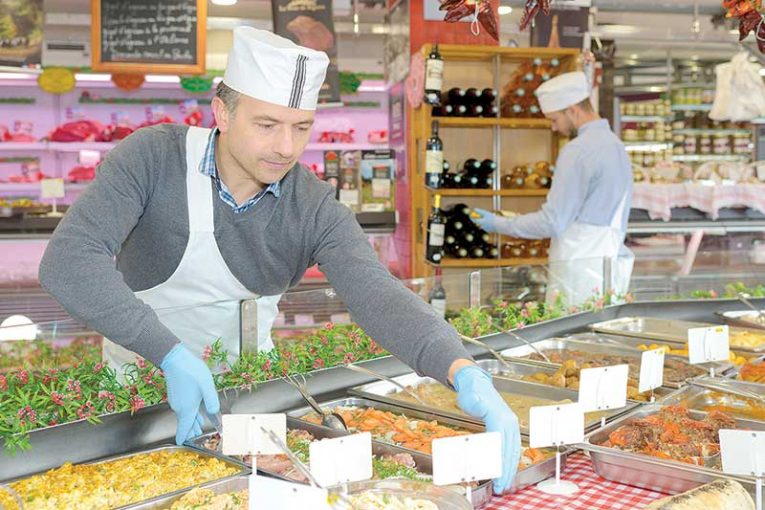Prepared Foods Will Continue To Drive Growth

by Karl Smith/SVP-member value, Produce Marketing Association
Prepared meals in supermarkets have gone from an intriguing trend to a force to be reckoned with.
Who is driving this trend? Millennials, of course. And they are driving it with gusto.
According to the Food Marketing Institute’s “The Power of Fresh Prepared/Deli,” a survey of retailers representing 8,000 stores, prepared foods accounted for 58 percent of the $24 billion in U.S. deli sales in mid-2016, making them an emerging driver of growth.

FMI’s report also shows:
• 69 percent of respondents reported growth of 5 percent or much higher in their prepared food departments compared to 8 percent that reported total store sales growth of more than 5 percent.
• 88 percent of the store banners polled said that they have a corporate executive chef on staff.
Want more numbers?
Technomic’s Retailer Meal Solutions Consumer Trend Report showed that, in 2014:
• Supermarket foodservice sales grew 5.9 percent.
• Convenience stores increased 2.4 percent.
• Other retailers grew 3.5 percent.
• The overall restaurant industry grew at a slower rate than supermarket foodservice, 3.8 percent.
What factors are driving this increase?
According to a Datassential report on the state of supermarket prepared foods, “consumer perceptions of supermarket prepared foods have been rising. The top two reasons consumers say they are purchasing more prepared foods are because of improvements in the variety and the quality of prepared foods.”
Technomic’s report points out that lower prices and the convenience of buying a meal at the same time as groceries resonates with consumers. The report goes on to note influences such as shoppers being too busy or tired to cook as well as the use of premium ingredients, healthful options, freshness indicators, cleanliness (which impacts perceptions of food safety) and the variety of items offered.
Consumers also have shown an increased interest in control. Over the past three years, the number of shoppers who said they found a self-serve hot food bar appealing or extremely appealing grew more than any other category, from 51 to 60 percent. Combined with made-to-order options and self-serve cold food bars, retailers can meet consumers’ desire to take greater control of meals, especially in terms of portion control and customization.
This recent growth has created optimism. Looking ahead, 75 percent of operators anticipate higher prepared food sales in 2017, Datassential found.
And why not? A survey of U.S. diners in Technomic’s report showed that over a three-month period, 85 percent enjoyed a meal at a restaurant and 95 percent had a meal at home. Not surprising, but that same survey showed that nearly as many diners had a meal of grocery prepared foods (57 percent) as drive-thru restaurants (63 percent) and carryout restaurants (53 percent).
Like so many changes in society, Millennials are driving this trend.
The Technomic report also shows that, overall, the number of people who answered “yes” to “I’d like retail stores to offer more prepared foods that feature ethnic flavors/ingredients” increased 4 percent (to 44 percent) from 2012-15. Meanwhile, the 2015 survey showed 56 percent of Millennials answered yes to the same question.
So there’s been growth. And there’s the potential for more growth. But this may be just scratching the surface.
Statistically, Millennials visit grocery stores less frequently than other generational groups. Fulfilling their desire for authentic flavors can bring them through the door.
CNBC quoted David Portalatin, VP of industry analysis at The NPD Group as saying “Give the Millennials what they want—fresh, healthier fare and a decent price—and they will come.”
The NPD Group called supermarkets offering a wide variety of prepared options “grocerants,” a term that increasingly is being used. These “grocerants,” according to The NPD Group, “received higher ratings for variety, healthy options, freshness and quality than traditional quick-service restaurants, according to The NPD Group information.”
These qualities are important to Millennials and will remain a key part of their eating behaviors as they age, The NPD Group said.
“Millennials’ interest in the benefits and experience supermarket foodservice offers will continue to be strong over the next several years,” Portalatin said. “This forecast bodes well for food manufacturers and retailers who have their fingers on the pulse of what drives this generational group.”
To sustain growth, retail operators and their suppliers will need to innovate with new dishes featuring seasonal, ethnic and unique flavors as competition escalates. Stand-alone meal solutions are emerging, while an ever-growing number of restaurants are rolling out grab-and-go and delivery options—all of which will encroach on supermarkets’ quick, convenient occasions.
In addition to increasing convenience and variety, a key area of opportunity lies in offering more healthy options. The majority of consumers purchase foods with “health halo” claims more often at grocery stores than at restaurants, and as more consumers look for more healthful prepared foods, retailers should consider offering more fruit and vegetable dishes as well as utilizing more healthful preparations. Emphasizing healthfulness could help retailers position their offerings as a nutritious replacement for home-cooked meals.
No comments:
Post a Comment